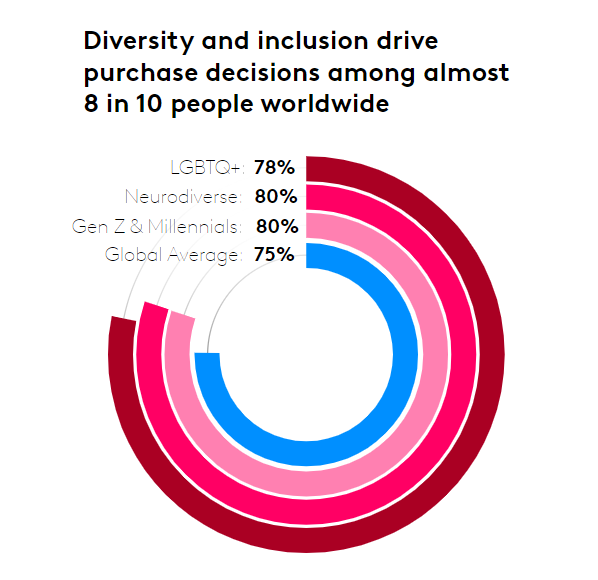Imagine turning down 18% of your sales – deciding as a company that you can do without that revenue. Or agreeing that one in six potential customers just don’t matter to you.
That’s exactly what you’re doing as a brand if you’re not being inclusive. That 18% of sales? It represents over-65s in OECD countries. Ignoring one in six people? You might be guilty of it, if you’re not marketing to people with some form of disability.
Diversity and inclusion are key to brand growth: our first Brand Inclusion Index reveals that D&I influences buying decisions among almost 8 in 10 people worldwide. And as experts in brand growth, we know that one of the fundamental tenets to scaling your brand is to predispose more people to it. As it turns out, if you stop excluding people, then new customers become much easier to find.
In fact, preliminary research from the Unstereotype Alliance with Oxford University’s Saïd Business School, using data from Alliance members including Kantar, has found that progressive, inclusive advertising drives a significant sales uplift – over 16% when compared with less progressive ad content. Not only that, but it also has a significant impact on consumers’ loyalty and buying intentions and on a brand’s pricing power. Excluding people based on who they are isn’t just unacceptable – it doesn’t make business sense.
And the importance of being inclusive is only going to keep growing. Our Brand Inclusion Index reveals that globally, diversity, fairness, and inclusion are even more important to millennials and Gen Z than other groups. As these populations grow in size – and grow their buying power – diversity and inclusion will also carry more weight.

The good news is that many brands are trying, and this isn’t going unnoticed. Almost two in three people – 65% – think most brands are making an effort to be more diverse and inclusive. But we still see too many who feel advertisers are missing the mark.
In fact, 8% of the global population feels that adverts never represent them at all. That means that not one of the ads they see every day, whether on their mobile, at the cinema, in the supermarket, or somewhere else, is speaking to them on a human level. In some countries, this figure is as high as 20%. This is unacceptable.
Not only that, almost half the global population experienced discrimination in the last year – a percentage that is significantly higher among key demographics for inclusive growth, such as LGBTQ+ communities. Almost three in five of these instances of discrimination (58%) took place in a commercial location.
The benefits of leading on inclusivity
It’s a no-brainer that the most inclusive brands around the world are also the most successful. The brands topping our Brand Inclusion Index, chosen by people around the world as the most inclusive, lead their industry in terms of innovation for inclusion, diversity and inclusion of their workforce, inclusive advertising, and fair customer experience.
They are also the brands that enjoy financial success, including greater market share and high brand equity. This is true of our overall winner for Most Inclusive Global Brand, Google, recognised for inclusive product innovations such as voice and other accessible technologies, its diverse workforce and the positive social impact it makes on a global scale. One person surveyed noted that “every Google product ad I’ve seen was always representing a different ethnicity, culture, disability” while another spoke of how the company allowed people to use its products to generate an income and “increase the capacity of [our] resources to make life easier and without any discrimination”.
Closing the inclusion gap
There’s only one way to reach those voices which are under-represented – and that is to listen to them. And while everyone’s experiences, desires and needs are unique, we analysed the views of more than 20,300 people around the world and found clear patterns in how they want to be seen.
Authentic representation is vital if brands want to make diversity and inclusion feel natural rather than forced. It needs to be an intrinsic part of the brand story, in front of and behind the camera.
People are tired of aspirational beauty. They want realistic representation that shows a diversity of skin tones, features, and hair textures. Body and age inclusivity are important. Ageism needs to be challenged – we heard from people as young as 40 who feel invisible.
We heard from many in emerging markets who want stronger local representation, whether appearance (the avoidance of colourism) or through more inclusion of local and regional languages, dialects and accents. And often-marginalised groups such as Indigenous communities, tired of stereotypes, are seeking positive representation in brand communications.
The world is making great strides in tackling inequalities and raising awareness of just how different people’s experiences can be. But this challenge has no end point, and our industry can always strive to get better. Marketers should still be looking to the future, ensuring that they keep meeting the needs of undervalued groups – or they risk both cultural irrelevance and losing commercial opportunities.
For more information, explore our Brand Inclusion Index campaign page

